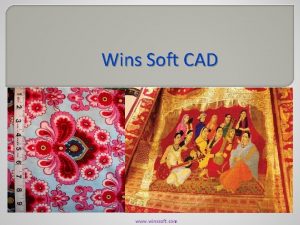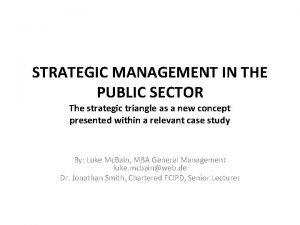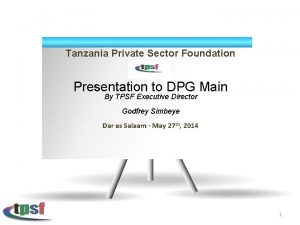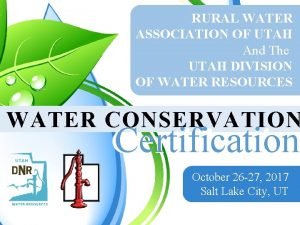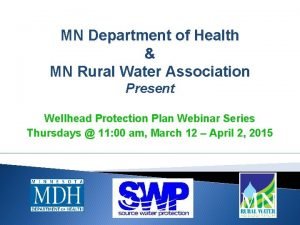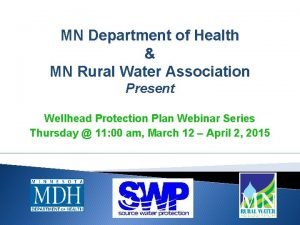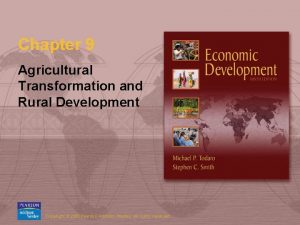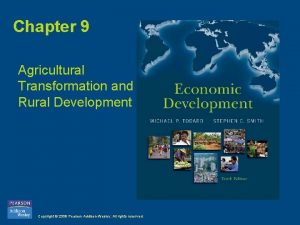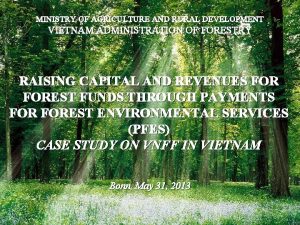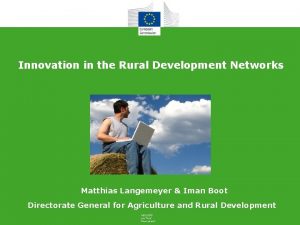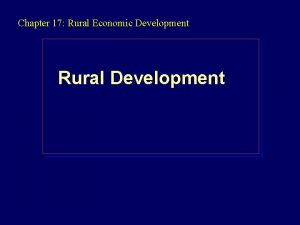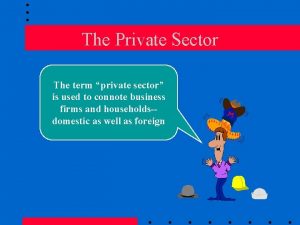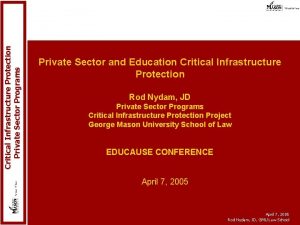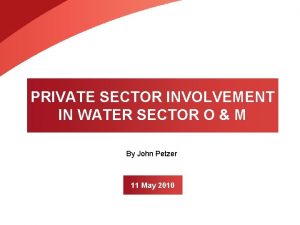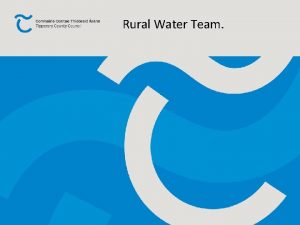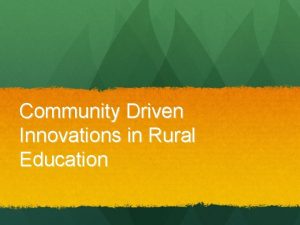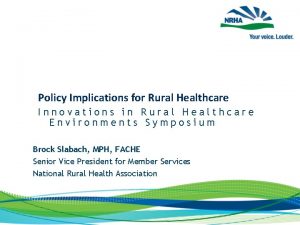Innovations for Private Sector Development in Rural Water













- Slides: 13

Innovations for Private Sector Development in Rural Water Supply Vietnam

Background in Vietnam • 86% of rural population used clean water, while 45% used water of the Ministry of Health’s standards, however, the coverage in mountainous provinces, and further in remote communes are much lower, many communes have no access to clean water • In a number of provinces, the non-functional schemes are as high as 60 -70%, most of them managed by the local communities.

COVERAGE PROBLEMS Ø In Vietnam, significant improvements have been made in rural water access over the past two decades. However, disparities between provinces remain, with access to safe water ranging from as low as 10% up to 65%. Poor communities in mountainous and remote areas are those most likely to be excluded from clean water access.

Reforming Rural Water Services CPC and community management models are not sustainable What is needed: ØAccountability and transparency ØProfessional management ØFinancial autonomy ØA level playing field • • Improve sector monitoring and (soft) regulation Private enterprises are part of the solution

Role of the Private Sector • Private Sector has managed 2. 9% of the total schemes (437 out of 14, 911 schemes; valued at VND 3, 050 billion, accounting for 15% total investment of 19, 654 billion in total in the sector. • Sustainability: according to a survey from 24 locals supported by EMW, the sustainable schemes managed by the private sector is 69%, higher than the general sustainable at rate of 50%.

EXISTING BARRIERS Private sector faced many barriers to investing in rural water supply: Water tariff too low Weak government support Serving the poor and recovering costs Low private investment Clean water is a considered a special commodity and historically water tariffs have been insufficient to allow for full cost recovery. Government support to private enterprises (through socialization) is unclear, and there was a lack of clear guidelines and structures for PPPs. Serving the poor remained difficult given their inability to pay, rendering it even more challenging to apply a full cost recovery tariff. Sector governance is yet to enable private enterprises to invest where there opportunities to be more attractive to private investment.

PSI PROJECT • • East Meets West Foundation (EMW) in Vietnam is implementing an innovative project to encourage private investment in the rural water supply, named Innovations for Private Sector Development Project is funded by the Australian Department of Foreign Affairs and Trade (DFAT). EMW has implemented the pilot phase in Son La and Ha Nam from 2016 -2017 and phase 2 in Ha Nam and Nghe An in partnership with Pcerwass, NCERWASS and Women’s Union.

INNOVATION Smart Subsidies EMW set up a competitive fund to provide outputbased aid subsidies to encourage private enterprises to bid 1 Balancing Economic and Social Benefits 2 Australian investment maximizes social welfare for rural households and supports the financial sustainability of private enterprises Policy Influence 3 A method for calculating full cost recovery tariffs and smart subsidy levels has been introduced and will guide the related provincial departments through a tariff reform roadmap

OBA smart subsidy mechanism

Implementation Experience from PSI in Son La COST ITEM ØLower cost than in public/donor schemes Donor Construction ØGreater leverage of public Private Investment funds due to private investment Beneficiary Contribution ØTotal public investment per household only USD 195 (~ 4. 4 Total Construction Cost million VND) EMW Planning, Design, Monitoring & Training TOTAL COST per HH USD/HH 125 135 20 280 70 350

RESULTS Outcomes: Ø Selected private enterprises expressed strong appreciation of the smart subsidy mechanism as the procedure was much more transparent and efficient Ø New piped water connections serving 7, 000 households by five private enterprises Ø A method for calculating full cost recovery tariffs and smart subsidy levels introduced and a water tariff reform ‘roadmap’ agreed with three provinces 3 Ø Private enterprises engaging in the program: • Shortened their construction time to receive reimbursement (from an average of 12 months under traditional input based financing, to 5 months) • Focused more on efficiency in order to win the competitive tendering process • Have the chance to access to advanced digital monitoring system for better integrated management of water schemes • Have the opportunity to learn from advanced technology (AWA Oz Water, Vietwater, twinning program) Ø The private enterprises in Son La province have demonstrated great appreciation to the innovative approach and support from the project. Government partners are working closely with EMW and the Australian Embassy to review the process for calculating the full cost recovery tariff and smart subsidy for adoption in future investments.

PROJECT PHOTOS

Thank you! NGUYỄN HỒNG HẠNH Regional Program Director Hanh. nguyen 1@eastmeetswest. org
 Water and water and water water
Water and water and water water Wins soft innovations private limited
Wins soft innovations private limited Political management in strategic triangle
Political management in strategic triangle Kuwaitization private sector
Kuwaitization private sector Tanzania private sector foundation
Tanzania private sector foundation Private limited company advantages and disadvantages gcse
Private limited company advantages and disadvantages gcse Rural water of utah
Rural water of utah Minnesota rural water association
Minnesota rural water association Mn rural water
Mn rural water Chapter 9 agricultural transformation and rural development
Chapter 9 agricultural transformation and rural development Chapter 9 agricultural transformation and rural development
Chapter 9 agricultural transformation and rural development Ministry of agriculture and rural development cameroon
Ministry of agriculture and rural development cameroon Ecotourim
Ecotourim Rural development
Rural development

